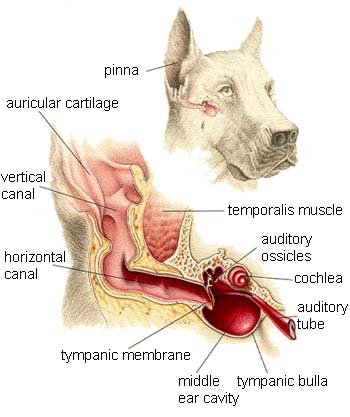The dog’s ear is an amazing and unique part of their anatomy. It is crucial to the way they function, and provides a level of hearing several times more powerful than man’s. In this brief article, we’ll go through some of the physiology of dog ears, as well as their basic construction. The dog’s outer ear is made up of the earflap, which is also termed a pinna, and can stand upright (sometimes called a prick ear) or have a floppy appearance. The earflap acts as a funnel to direct sound through the ear canal, and can be rotated in several angles, and perked up or let down in some dogs to heighten or dampen the sense of hearing.
Dog ears are extremely sensitive, largely because they are constructed so differently than the ears of humans. It is proposed that dogs hear more than six times more accurately than humans. They are made from three parts, consisting of the outer ear, the middle ear, and the inner ear. The outer ear is made up of the ear flap, which is often called a pinna, and can be floppy or pricked up. This acts as a funnel to direct sound into the ear canal, which, unlike in humans, is thin and narrow.
The outer and middle ear are separated by a thin membrane called the eardrum. This membrane is extremely fragile, and can be damaged by infections or during ear cleaning. This middle ear is made up of three bones, the bulla (a cavity filled with air), and a thin tube that goes to the back of the mouth. The inner ear, which is connected directly to the brain, controls balance and hearing. Dog ears are notorious for their infections and problems, especially dogs with large, floppy ears or that spend a lot of time in water. Dogs that have lots of hair in and around the ears are also prone to ear infections.
If the ear gets itchy for whatever reason (some dogs develop skin conditions that lead to constant scratching), scratching it may result in loss of hair on the earflap or even at the ear’s base. Overly severe scratching may even lead to tears at the ear’s edges. Damage to the dog ears can cause bleeding between the skin and the cartilage of the earflap, which is called a hematoma (much like a severe bruise). The earflap gets swollen and hot and painful, but can be treated much like any bruise.
Sherry Harris is the author of a wide range of dog topics including, but not limited to: puppy training, dog grooming, pet travel, pet insurance, dog training, pet food, house training, dog breeds and dog allergies. For hundreds more free dog articles visit http://www.DogStyleNetwork.com Hope you enjoyed the article topic Dog Ears. Check out our dog grooming products. We are online 24/7, so come visit us at your convenience!

